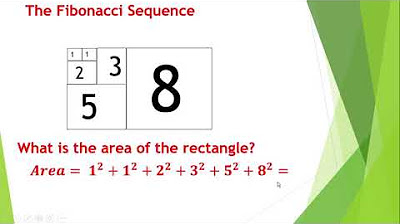The Fibonacci Sequence and Rabbits with Math Dude, Jason Marshall
Summary
TLDRIn this Math Dude video, Jason Marshall explores Fibonacci's rabbit problem, a classic sequence where each number is the sum of the two preceding ones. Starting with a single pair of newborn rabbits that mature and reproduce monthly, the population grows exponentially. By the 12th month, there are 144 pairs, but the actual count at the end of the year is 233 pairs, or 466 rabbits. This contrasts sharply with exponential growth, where doubling monthly would result in 8,192 rabbits after a year.
Takeaways
- 🐰 The script discusses Fibonacci's rabbit problem, a classic mathematical problem involving the growth of a rabbit population over time.
- 📝 Fibonacci's question assumes that each pair of rabbits produces one male and one female offspring every month, and they can start reproducing at one month old.
- 🔁 The rabbits are immortal in this scenario, meaning they never die, which allows for continuous population growth.
- 🌱 The initial condition is one pair of newborn rabbits, which are too young to reproduce in the first month.
- 👫 By the second month, the original pair matures and produces one new pair, resulting in two pairs in total.
- 🐇 The pattern of growth follows the Fibonacci sequence, where each number is the sum of the two preceding ones, starting from 1, 1, 2, 3, 5, 8, and so on.
- 🔢 After 12 months, the number of rabbit pairs in the pen at the beginning of the month is 144, which is the 12th Fibonacci number.
- 📈 However, the actual number of rabbit pairs at the end of the year is 233, which corresponds to the 13th Fibonacci number.
- 🐰 The total number of rabbits at the end of the year is 466, calculated by doubling the number of pairs since each pair consists of two rabbits.
- 🔗 The exponential growth model of the rabbit population is contrasted with a hypothetical geometric sequence growth, where the population would double each month.
- 🌐 If the rabbits grew geometrically, there would be 8,192 rabbits after a year, highlighting the significant difference between exponential and geometric growth.
Q & A
What is the central topic of the video script provided?
-The central topic of the video script is Fibonacci's rabbit problem, which explores the exponential growth of a rabbit population over a year based on certain assumptions.
What are the initial conditions of the rabbit problem as stated in the script?
-The initial conditions are that two newborn rabbits are placed in a pen, and it is assumed that rabbits can reproduce once per month, produce one male and one female offspring, can start reproducing at one month old, and never die.
How does the number of rabbit pairs increase each month according to the script?
-Each month, the number of rabbit pairs increases by the sum of the previous two months' pairs, following the Fibonacci sequence, where each new number is the sum of the two preceding ones.
What is the Fibonacci sequence as mentioned in the script?
-The Fibonacci sequence is a series of numbers where each number is the sum of the two preceding ones, starting from 1, 1, 2, 3, 5, 8, and so on.
How many pairs of rabbits are there at the beginning of the 12th month according to the script?
-At the beginning of the 12th month, there are 144 pairs of rabbits, which is the 12th Fibonacci number.
What is the actual number of rabbit pairs at the end of the 12th month?
-At the end of the 12th month, the actual number of rabbit pairs is 233, which is the 13th Fibonacci number.
How many rabbits would there be if the population doubled every month for a year?
-If the rabbit population doubled every month for a year, there would be 8,192 rabbits at the end of the year.
What is the difference between the exponential growth model and the Fibonacci sequence in terms of rabbit population growth?
-The exponential growth model would result in 8,192 rabbits at the end of a year if the population doubled every month, whereas the Fibonacci sequence, which is the model used in the script, results in 233 pairs or 466 rabbits at the end of the 12th month.
Who is the presenter of the video script?
-The presenter of the video script is Jason Marshall.
What conclusion does the script draw about the rabbit population growth?
-The script concludes that the rabbit population growth, when modeled by the Fibonacci sequence, is significantly different from the exponential growth model, showing a much slower increase in the number of rabbits.
What is the main takeaway from the video script about the nature of growth?
-The main takeaway is that the nature of growth can be very different depending on the model used, and the Fibonacci sequence provides a more realistic model for the growth of the rabbit population in this scenario.
Outlines

Этот раздел доступен только подписчикам платных тарифов. Пожалуйста, перейдите на платный тариф для доступа.
Перейти на платный тарифMindmap

Этот раздел доступен только подписчикам платных тарифов. Пожалуйста, перейдите на платный тариф для доступа.
Перейти на платный тарифKeywords

Этот раздел доступен только подписчикам платных тарифов. Пожалуйста, перейдите на платный тариф для доступа.
Перейти на платный тарифHighlights

Этот раздел доступен только подписчикам платных тарифов. Пожалуйста, перейдите на платный тариф для доступа.
Перейти на платный тарифTranscripts

Этот раздел доступен только подписчикам платных тарифов. Пожалуйста, перейдите на платный тариф для доступа.
Перейти на платный тарифПосмотреть больше похожих видео

On Fibonacci Sequence (GEC 104- Math in the Modern world)

Math Dude 016 • Video Extra! • The Fibonacci Sequence...and Rabbits!

EMODULE 1.2 - The Fibonacci Sequence

Unit 1 | Lesson 3: The Fibonacci Sequence (Mathematics in the Modern World)

THE FIBONACCI SEQUENCE AND THE GOLDEN RATIO || MATHEMATICS IN THE MODERN WORLD

Fibonacci Sequence
5.0 / 5 (0 votes)
